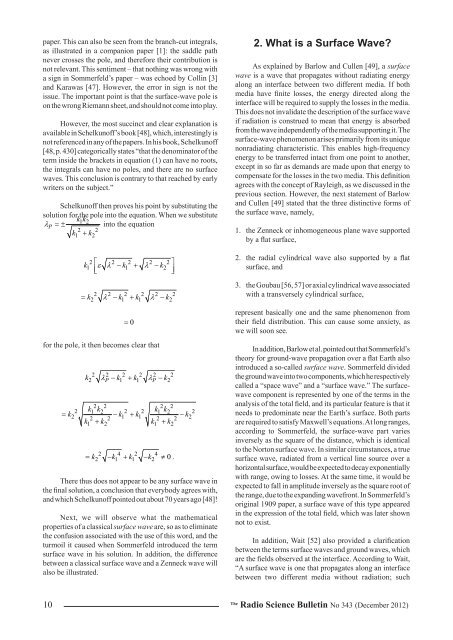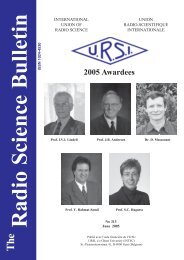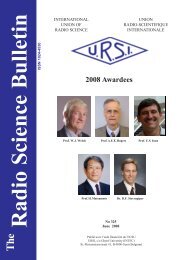December 2012 - URSI
December 2012 - URSI
December 2012 - URSI
You also want an ePaper? Increase the reach of your titles
YUMPU automatically turns print PDFs into web optimized ePapers that Google loves.
paper. This can also be seen from the branch-cut integrals,<br />
as illustrated in a companion paper [1]: the saddle path<br />
never crosses the pole, and therefore their contribution is<br />
not relevant. This sentiment – that nothing was wrong with<br />
a sign in Sommerfeld’s paper – was echoed by Collin [3]<br />
and Karawas [47]. However, the error in sign is not the<br />
issue. The important point is that the surface-wave pole is<br />
on the wrong Riemann sheet, and should not come into play.<br />
However, the most succinct and clear explanation is<br />
available in Schelkunoff’s book [48], which, interestingly is<br />
not referenced in any of the papers. In his book, Schelkunoff<br />
[48, p. 430] categorically states “that the denominator of the<br />
term inside the brackets in equation (1) can have no roots,<br />
the integrals can have no poles, and there are no surface<br />
waves. This conclusion is contrary to that reached by early<br />
writers on the subject.”<br />
Schelkunoff then proves his point by substituting the<br />
solution for the pole into the equation. When we substitute<br />
kk 1 2<br />
P<br />
<br />
into the equation<br />
2 2<br />
k k<br />
1 2<br />
k<br />
<br />
k k<br />
<br />
2 2 2 2 2<br />
1 1 2<br />
<br />
<br />
2 2 2 2 2 2<br />
2 1 1 2<br />
k k k k<br />
0<br />
for the pole, it then becomes clear that<br />
2 2 2 2 2 2<br />
2 P<br />
1 1 P<br />
2<br />
k k k k<br />
2 2 2 2<br />
2 k1 k2 2 2 k1 k2<br />
2<br />
2 2 2 1 1 2 2 2<br />
k1 k2 k1 k2<br />
k k k k<br />
2 4 2 4<br />
2 1 1 2 0<br />
k k k k<br />
.<br />
There thus does not appear to be any surface wave in<br />
the final solution, a conclusion that everybody agrees with,<br />
and which Schelkunoff pointed out about 70 years ago [48]!<br />
Next, we will observe what the mathematical<br />
properties of a classical surface wave are, so as to eliminate<br />
the confusion associated with the use of this word, and the<br />
turmoil it caused when Sommerfeld introduced the term<br />
surface wave in his solution. In addition, the difference<br />
between a classical surface wave and a Zenneck wave will<br />
also be illustrated.<br />
2. What is a Surface Wave?<br />
As explained by Barlow and Cullen [49], a surface<br />
wave is a wave that propagates without radiating energy<br />
along an interface between two different media. If both<br />
media have finite losses, the energy directed along the<br />
interface will be required to supply the losses in the media.<br />
This does not invalidate the description of the surface wave<br />
if radiation is construed to mean that energy is absorbed<br />
from the wave independently of the media supporting it. The<br />
surface-wave phenomenon arises primarily from its unique<br />
nonradiating characteristic. This enables high-frequency<br />
energy to be transferred intact from one point to another,<br />
except in so far as demands are made upon that energy to<br />
compensate for the losses in the two media. This definition<br />
agrees with the concept of Rayleigh, as we discussed in the<br />
previous section. However, the next statement of Barlow<br />
and Cullen [49] stated that the three distinctive forms of<br />
the surface wave, namely,<br />
1. the Zenneck or inhomogeneous plane wave supported<br />
by a flat surface,<br />
2. the radial cylindrical wave also supported by a flat<br />
surface, and<br />
3. the Goubau [56, 57] or axial cylindrical wave associated<br />
with a transversely cylindrical surface,<br />
represent basically one and the same phenomenon from<br />
their field distribution. This can cause some anxiety, as<br />
we will soon see.<br />
In addition, Barlow et al. pointed out that Sommerfeld’s<br />
theory for ground-wave propagation over a flat Earth also<br />
introduced a so-called surface wave. Sommerfeld divided<br />
the ground wave into two components, which he respectively<br />
called a “space wave” and a “surface wave.” The surfacewave<br />
component is represented by one of the terms in the<br />
analysis of the total field, and its particular feature is that it<br />
needs to predominate near the Earth’s surface. Both parts<br />
are required to satisfy Maxwell’s equations. At long ranges,<br />
according to Sommerfeld, the surface-wave part varies<br />
inversely as the square of the distance, which is identical<br />
to the Norton surface wave. In similar circumstances, a true<br />
surface wave, radiated from a vertical line source over a<br />
horizontal surface, would be expected to decay exponentially<br />
with range, owing to losses. At the same time, it would be<br />
expected to fall in amplitude inversely as the square root of<br />
the range, due to the expanding wavefront. In Sommerfeld’s<br />
original 1909 paper, a surface wave of this type appeared<br />
in the expression of the total field, which was later shown<br />
not to exist.<br />
In addition, Wait [52] also provided a clarification<br />
between the terms surface waves and ground waves, which<br />
are the fields observed at the interface. According to Wait,<br />
“A surface wave is one that propagates along an interface<br />
between two different media without radiation; such<br />
10 The Radio Science Bulletin No 343 (<strong>December</strong> <strong>2012</strong>)
















